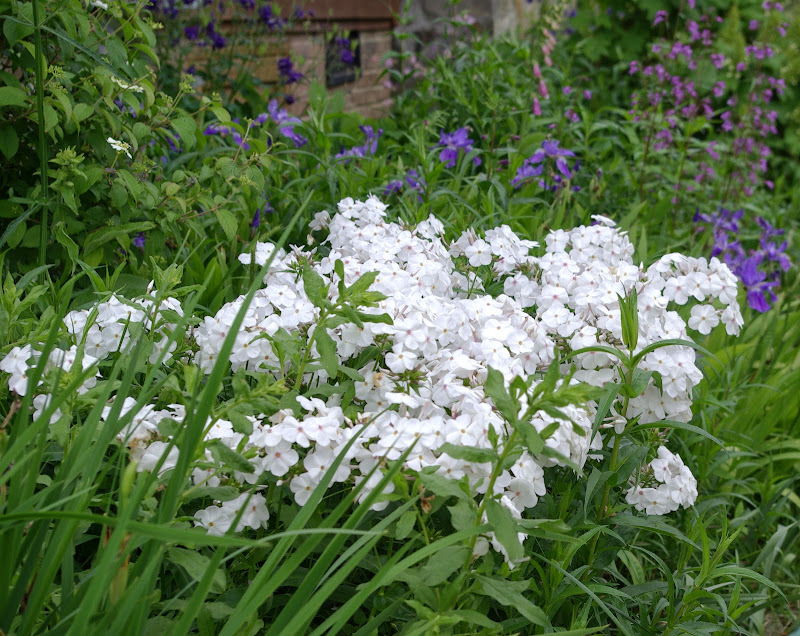As I wrote in an earlier post, the east side of my house is my experimental laboratory for plants that need some shade and/or sharp drainage all year. Peonies dislike wet feet so my collection of 2 resides beside the house.
Peony 'Festiva Maxima'

Peony 'Raspberry Sundae'

Foxglove doesn't like being soggy in winter either.

doesn't need part shade or dryish winters, but I wanted another spring phlox next to the house to go along with Woodland Phlox and I figured it'd be happier than Marsh Phlox.
I know people grow Siberian Iris in ponds in some parts of the country, but here they seem to do best on the dry side. For a while I planted them in damp places (the edges of ditches and other low places) and they either stayed small or just died. Then I got a bluish-purple iris in a trade and on a whim stuck a piece of it next to the house, where it grew into a big clump. Here it is with Phlox 'Minnie Pearl' and Japanese Roof Iris.
I was on a quest to find a mid-size white phlox after seeing one that lined the driveway of a house that I drive by on the way to the feed store. May have just been a short 'David' but everything about it was smaller and it bloomed a good month earlier. I think I found the closest thing to it that I could find (if it isn't an exact match) at Plant Delights with 'Minnie Pearl'. It's thought to be a naturally occurring hybrid between
Phlox maculata and possibly
Phlox glaberrima. The mystery phlox could also be
Phlox carolina 'Miss Lingard'.
Japanese Roof Iris likes living next to the house too, in this spot where it gets some sun until 3pm in summer. I am very fond of this iris with its rich lavender color and interesting purple spots and stripes.
The one damp place beside the house is under the faucet. I transplanted this Lyreleaf sage from the "road" between the floodway fields here. I actually prefer it to the cultivars with lots of burgundy on the leaves. These just have a tracing, but enough to be interesting and beautiful.
A Celandine Poppy has seeded itself under the faucet too, along with a columbine. Woodland Phlox and Gulf Coast Penstemon are on the left. I plug phlox divisions and penstemon seedlings in every available spot, since recent hot summers have made the bed beside the house very dry. Woodland phlox has struggled instead of spreading. In addition, Eastern Gray and Gulf Coast Penstemons seem to die off once they go to seed.
I've always liked the fairybell sort of quality of columbines and many seedlings reside next to the house.
The side side of the house is a place for my woodland treasures like Virginia Bluebells and native azaleas.
Coast Azalea

Coast azalea, left; Alabama azalea, right

I picked up this purple geranium from a lady in Selma who sells a lot of iris and peonies. It's very robust and I love the flowers.
The genus of Penstemons ranges in moisture preferences all over the spectrum, but many garden varieties prefer good drainage. I've had Penstemon 'Midnight' for 5 years now so it must like where it is.
I like the combination of P. 'Midnight' with the vanilla and strawberry blooms of Oakleaf Hydrangea 'Dayspring'. I have four oakleaf 'Pee Wee's in front of the house but this one tends to bloom and color earlier in the year and the blooms have a lot more pink in them.



























































